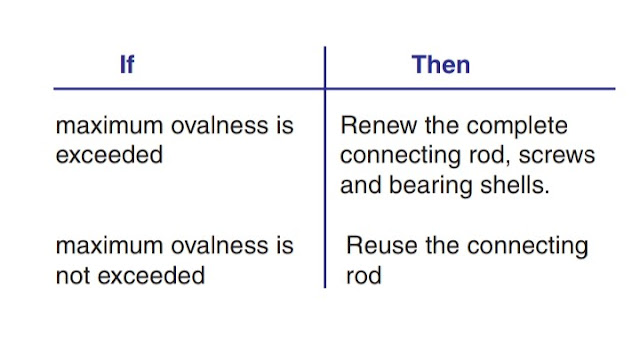THE PROCEDURE FOR OVERHAULING A FUEL PUMP OF AUXILIARY ENGINE ARE AS FOLLOWS:
1.Dismounting of fuel injection pipe.
1) Remove the high pressure pipe.
2.Dismounting of Fuel and Drain Pipes
2) The lock ring (1), see fig 2 must be shifted into the groove in the center of the pipe.
3) Push the fuel and drain pipes into the adjacent pump until the injection pump is free, see fig
3.Removal of Fuel Injection Pump
4) Separate the spring loaded lever from the regulating rod on the fuel injection pump.
5) Remove the screws in the bottom flange and take the fuel injection pump away.
4.Disassembly of the Pump Element
1) Loosen the 4 nbs. holding screws (63)
see fig
2) Press in the roller (26) by means of the installation device, see fig .
3) Screw off the blocking screw (349) which is the locking arrangement for rollar and pump spring .
4) Loosen the spring force and demount the installation device.
5) Take off the roller (26) and the roller pin (38).
6) Loosen the 2 nbs. Bolts(63) and take off the roller guide(51).
7) Pull out the thrust piece (171).
afterwards the pump spring (291), the spring plate (205), and control sleeve (266).
8) Turn the injection pump vertically by 180 degrees.
9) Loosen the cylindrical screws (421)
10) Remove the delivery socket (230) and the pressure valve complete(122)
14) Screw off the buffer bolt (242) which are two in nos on both side, it is the locking arrangement for plunger.
15) Carefully take out the pump element (87) with plunger and barrel
INSTALLATION
16) Pump elements can be exchanged as component groups only. (plunger and barrel).
17) Insert the barrel (99), see fig 1 carefully into the injection-pump casing (229) with an aluminum arbor and a non-fuzzing cloth to protect the high-pressure surface, and screw in the blocking screw (349).Tightening torque 5 Nm.
18) Further assembly see under "Exchange of pressure valve".
19) Turn the injection pump vertically by 180 degrees.
20) Install the control sleeve (266) - care for the marking! - control sleeve (266) milled tooth, control rack (254) groove around circumference.
21) The further assembly is carried in reciprocal order of disassembly (driving pin of the plunger in the direction of the slot of the control sleeve).
22) Marking on the driving pin, installed towards the boring of the control rack.
1.Dismounting of fuel injection pipe.
1) Remove the high pressure pipe.
2.Dismounting of Fuel and Drain Pipes
2) The lock ring (1), see fig 2 must be shifted into the groove in the center of the pipe.
3) Push the fuel and drain pipes into the adjacent pump until the injection pump is free, see fig
3.Removal of Fuel Injection Pump
4) Separate the spring loaded lever from the regulating rod on the fuel injection pump.
5) Remove the screws in the bottom flange and take the fuel injection pump away.
4.Disassembly of the Pump Element
1) Loosen the 4 nbs. holding screws (63)
see fig
2) Press in the roller (26) by means of the installation device, see fig .
3) Screw off the blocking screw (349) which is the locking arrangement for rollar and pump spring .
4) Loosen the spring force and demount the installation device.
5) Take off the roller (26) and the roller pin (38).
6) Loosen the 2 nbs. Bolts(63) and take off the roller guide(51).
7) Pull out the thrust piece (171).
afterwards the pump spring (291), the spring plate (205), and control sleeve (266).
8) Turn the injection pump vertically by 180 degrees.
9) Loosen the cylindrical screws (421)
10) Remove the delivery socket (230) and the pressure valve complete(122)
14) Screw off the buffer bolt (242) which are two in nos on both side, it is the locking arrangement for plunger.
15) Carefully take out the pump element (87) with plunger and barrel
INSTALLATION
16) Pump elements can be exchanged as component groups only. (plunger and barrel).
17) Insert the barrel (99), see fig 1 carefully into the injection-pump casing (229) with an aluminum arbor and a non-fuzzing cloth to protect the high-pressure surface, and screw in the blocking screw (349).Tightening torque 5 Nm.
18) Further assembly see under "Exchange of pressure valve".
19) Turn the injection pump vertically by 180 degrees.
20) Install the control sleeve (266) - care for the marking! - control sleeve (266) milled tooth, control rack (254) groove around circumference.
21) The further assembly is carried in reciprocal order of disassembly (driving pin of the plunger in the direction of the slot of the control sleeve).
22) Marking on the driving pin, installed towards the boring of the control rack.



































































